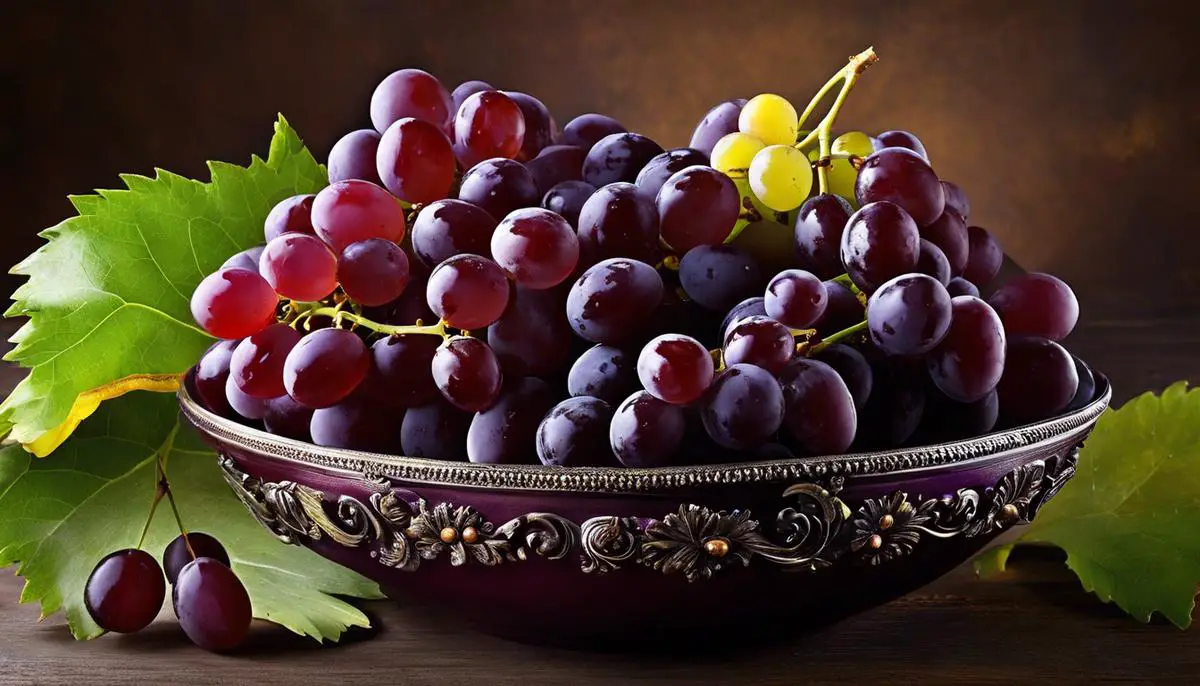
Champagne Grapes: two words that meld the tantalizing spirit of celebration, symbolic of enchanting festivities, with the simplicity of nature’s boon. These petite-sized wonders, with their compelling mix of gastronomic versatility and health benefits, have etched themselves a secure position in the variety chart of gastronomy. This study immerses itself into the captivating universe of Champagne Grapes, tracing their history and varieties, exploring their multifaceted culinary uses, and highlighting their nutritional prowess. Just as Champagne bubbles with vivacious elegance and complexity, so do these grapes, adding distinct notes of taste and charm to myriad culinary creations and pairings.
History and Variety of Champagne Grapes
Pop! The Fascinating Backstory and Unique Qualities of Champagne Grapes
The world of edibles is endlessly captivating, especially when we journey into the realm of fruits—and the Champagne grape is an exciting detour indeed! Food lovers everywhere have a special appreciation for the little intricacies that transform every bite into a moment of shared history and worldwide connection. Consider this a tasting menu of knowledge, my fellow epicures, and let’s explore the vintage charm of Champagne grapes together.
When we think of Champagne, we’re instantly transported to the vineyards of France—it’s a fizzy dream of luxury and refinement, isn’t it? Well, first course served—Champagne grapes aren’t actually used for making Champagne at all. Irony, thy name is viticulture! The term “Champagne grapes” is a North American misnomer referencing the grape variety called “Black Corinth.” The actual grapes used for making the renowned Champagne are primarily Chardonnay, Pinot Noir, and Pinot Meunier.
Onto our second course—the origin story! Named after the city of Corinth in Greece, the ‘Black Corinth’ or the ‘Champagne’ grape has been cultivated for thousands of years. Even the Greeks and Romans knew a good thing when they tasted it! It was during the 19th century, when this tiny grape variety was first shipped to the foreign markets, that it was referred to as the “Champagne” grape. Some attribute this nickname to their high-end appeal, sparking associations with the elegance of fine, sparkling wine.
As for what sets these tiny gems apart—course three, if you will—it’s in the beautifully balanced flavor profile. These demure darlings might be pint-sized, but their sweet, tangy taste is big on pronunciation. Their petite size also means a higher skin to flesh ratio—more skin equals more of those delightful tannins that add complexity and depth.
Champagne grape clusters are taut, tiny, and compact, looking much like the delicate beads of luxury jewelry—there’s certainly a feast for the eyes before the palate! Their marquee role? Garnishing cheese platters, desserts, and cocktails with their tiny, richly flavored and jewel-like presence. Don’t let the size fool you—these miniature orbs can heighten a sensory dining experience with their bold aesthetics and potent taste.
So the next time you spy these diminutive delights at the farmer’s market or splashed across a gourmet cheese platter, now you know the unique tale they have to tell. It’s not just grapes you’re nibbling—it’s a bite of ancient Corinthian history, a sip of North American naming whimsy, and a taste of extraordinary flavor unlike any other grape. That’s the beauty of food—it’s not just biochemistry and agriculture—it’s history, geography, and culture distilled into a single, delicious bite. Cheers to that, culinary adventurers!

Culinary Uses of Champagne Grapes
Unleashing the Culinary Potential of Champagne Grapes
Now that we’ve delved into the realm of flavor hidden within diminutive Champagne grapes and their intriguing origins, it’s time to push the boundaries of their culinary applications. At first glance, these tiny gems may seem more like a novelty rather than a pantry staple, yet their allure lies in their ability to blend familiar tastes with unexpected surprises.
Though Champagne grapes may not have a direct link to the bubbly elixir we affectionately call Champagne, they shine when utilized in a myriad of exciting recipes. Consider incorporating them into salads where they can lend a burst of sweetness that contrasts perfectly with the salty undertones of feta or goat cheese. Grapes, goat cheese, and grilled chicken salad, anyone?
And speaking of contrasts, why not try playing with temperatures? The combination of hot and cold can create an enticing juxtaposition in the realm of gastronomy. Try roasting Champagne grapes and adding them to an ice-cold sorbet or frozen yogurt. The resultant warm, caramelized fruit against the cold sweetness would be a dessert lover’s delight.
Now, if you’re looking for something truly unique, consider pickling these tiny powerhouses. That’s right, pickled grapes! Pickling can dramatically transform their flavor profile, taking them from sweet and tangy to a complex balance of sweet, tangy, and savory with an underlying hint of spice. These make an excellent accompaniment to charcuterie boards or even as an unconventional burger topping.
Looking for a fun and delicious appetizer option for your next dinner party? Why not make Champagne grape salsa? Combine them with some finely chopped jalapeno, onion, and a dash of lime juice. Serve with tortilla chips or as a topping for grilled fish for a refreshing, zingy bite.
In addition, we should not overlook the simple joy of enhancing baked goods with the inclusion of Champagne grapes. Think mini grape tarts, muffins, or scones. Cook them down to a syrupy reduction for an exquisite glaze for donuts or as a topping for pancakes or toast. The possibilities are limited only by your gastronomic imagination.
At its heart, flavorful cooking is all about adventure and discovery—the thrill of unearthing novel ways to enhance and elevate the foods we eat. And within the culinary landscape, few ingredients are as delightfully surprising as the humble Champagne grape. So the next time you spot these diminutive beauties at your local farmer’s market or grocery store, embrace the opportunity to augment your cooking repertoire and, most importantly, enjoy the ride.

Nutritional Benefits and Pairing Options
Good news for the health-conscious food adventurer – these tiny gems of edible joy bring numerous nutritional benefits, enlightening health in a delicious way. Boasting an impressive list of vitamins and antioxidants, Champagne grapes serve as a delightful path to better health. In fact, these petite pleasures are packed with vitamin K and flavonoids, known for boosting heart health and combatting inflammation. Not just this, they’re also a surprising source of dietary fiber which promotes digestion and overall gut health.
Also noteworthy is their low calorie count. One can please their palate without the worry of excessive calorie intake. What’s more, these burst of sweetness work their magic in enhancing mood as well. These small wonders are a rich source of flavonoids that help increase blood flow and improve cognitive functions, working wonders for your brain health while satisfying the taste buds.
While their health advantages are commendable, it’s their gourmet value that makes the Champagne grapes irresistibly attractive. How could they not? Their sweetness can cut through the fattiness of cheese, or balance the spiciness of arugula in a salad.
Imagine, a piece of baked brie, warm, bubbling, and golden on the outside, paired with a sweet, light Champagne grape compote. The richness of the cheese dances seamlessly with the bright fruitiness of the grapes, creating an indulgent symphony of flavors. Or consider this – a sharp, tangy goat cheese paired with a handful of these grapes, a drizzle of honey, and a sprig of fresh thyme, definitely something to rave about at a picnic lunch.
But don’t stop there, these grapes blend seamlessly with diverse beverage options. The tiny grapes create an unexpected pop of flavor in a chilled glass of white sangria, their sweetness complementing the citrus juices and white wine perfectly. Or think about a steaming cup of chamomile tea with a Champagne grape scone on the side, an elegant taste of refined indulgence.
Inspired to go beyond the traditional uses? Consider adding these grapes to your baking exploits. Imagine muffins studded with Champagne grapes, their sweetness amplified as they caramelise during baking. Or swirl them into a creamy cheesecake batter for a unique textural contrast.
Ever played with pickling these little gems? They add a sweet-tangy element to an antipasto platter, their bursts of flavor complementing salty cured meats and sharp cheeses. Transform them into a vibrant salsa for a fresh spin on a Mexican classic. Even in salads, their sweet pop goes well with bitter greens, offering a balance of flavors.
One could go on extolling this grape’s versatility in the kitchen. Remember, the joy in cooking lies in creating a journey of taste exploration. So, go forth, experiment with this food artifact, and find out what makes Champagne grapes a favorite among gourmets. Revel in their heritage and taste. It’s more than just food. It’s about connecting to a piece of history in the tiny form of a grape. Cook with excitement, eat with joy, and live each day with a love for food!

The culinary world’s fondness for Champagne Grapes is not exclusive or unfounded. These grapes carry within their tiny forms an essence that is a blend of history, flavor, versatility, and healthfulness. Their role does not cease with lending a hint of luxury to our dessert plates or a flavorful depth to our sauces. They continue to contribute to our well-being with their rich nutrient profile, extending their influence far beyond the realm of taste. To relish Champagne Grapes is to appreciate their journey—a journey from vine to wine, from antiquity to modernity. As you pair them creatively with diverse eats and wines, you experience an orchestrated symphony of taste that indeed makes every bite an occasion.



